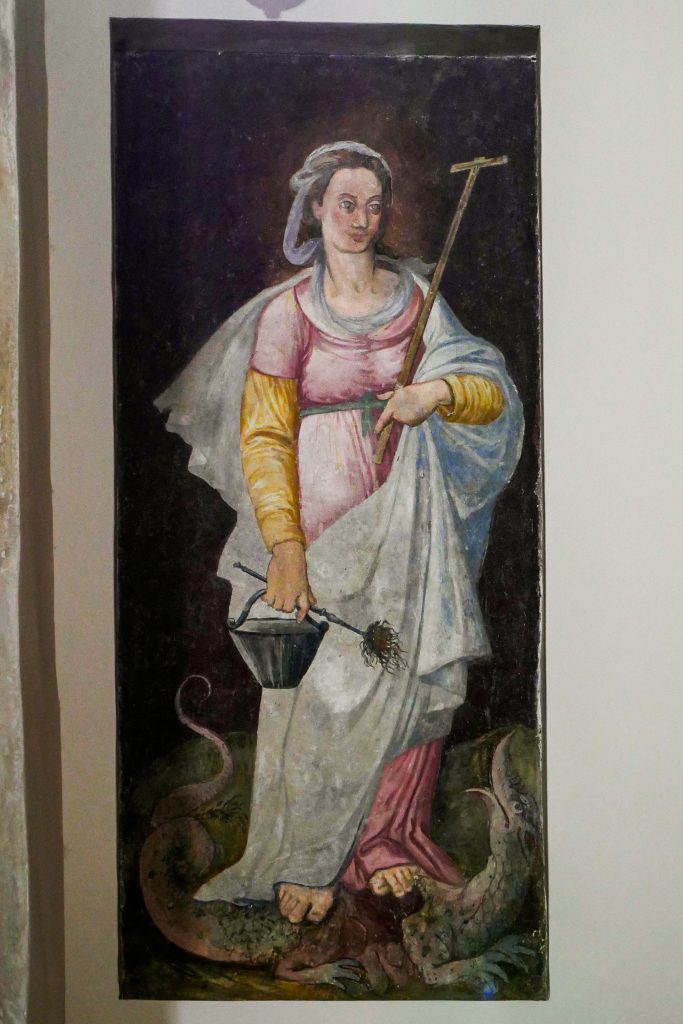Margaret of Antioch
4th Century Martyr
Though her story is likely fictitious, the hagiography of Margaret of Antioch has stood the test of time, encouraging Christians through the centuries. Her legend reports that Margaret was purportedly martyred during the Diocletian persecution, but there are no contemporary sources that reference her. The earliest primary sources about Margaret’s life are centuries after her death, the first being Greek writings from the eighth century, Rabanus Maurus’s Martyrology from the ninth century, and other various Anglo-Saxon versions also from the ninth century. Other versions of Margaret’s tale continued to appear, one of the most popular from the Golden Legend, a collection of hagiographies that was widely read during the Middle Ages. Narrations of the story depended on the geographical location of the rendition, nonetheless, as the primary sources began to appear in the eighth century, Margaret’s popularity grew.



Hagiography – Also known as Marina in the Eastern church, Margaret was a shepherdess born in Antioch of Pisidia and was the daughter of a pagan priest. Her mother died when she was twelve years old, and Margaret’s care was passed to a nurse. Under this nurse’s care, Margaret converted to Christianity. Margaret’s martyrdom story begins similarly to other virgin martyrs of the early church. A Roman prefect named Olybrius was inflamed with love for Margaret, and he sought to court her. Margaret refused to marry Olybrius because of her devotion to Christ and her commitment to virginity. In refusing his proposal, the Golden Legend recounts her response, “Christ gave himself over to the death for me, and I desire gladly to die for Christ.”
As the story goes, Margaret was imprisoned for her repudiation to marriage. While captive, Margaret prayed for a vision of the enemy she was to face; her prayer was answered, and a devil appeared to her in the form of a dragon and swallowed her whole. Yet while inside the belly of the dragon, Margaret made the sign of the cross, and the dragon proceeded to expel her, rendering it asunder. Thereafter, this devil emerged again, now in the form of a black demon. Margaret forcefully caught and attacked the demon, and triumphantly defeated it. According to the Golden Legend, she stated, “Lie still, thou fiend, under the feet of a woman.”
Despite these victories, Margaret was then tortured, and stories recount the gruesome beatings that she endured. Nonetheless, Margaret fearlessly embraced this suffering knowing that Christ ultimately had power over her body and soul. After these feats, Margaret refused to sacrifice to pagan gods and recant her faith which led to her public beheading. Immediately before execution, Margaret prayed on behalf of those who would invoke her name, and these prayers vary depending on their Greek or Latin translations. Upon her death, some story renditions include the claim that angels carried Margaret’s head to heaven.
Though Margaret’s story is likely fictitious, she has inspired many Christians over the centuries. Cults of Saint Marina in the East and Saint Margaret in the West emerged during the Middle Ages, with different emphases on her stories in both regions. In the East, she was viewed as a protector from demonic forces. In the West, there was a focus on her ability to help women during childbirth, reminiscent of her bursting forth from the belly of the dragon. However, only in the eleventh century was Margaret invoked as the patron saint of childbirth. Margaret was also one of the women that Joan of Arc purportedly heard, and she is one of the fourteen Holy Helpers. St. Marina is still venerated in the East and though the Vatican de-canonized her in 1969 due to the unlikelihood of her story, some still celebrate her feast day on July 20th.
